My 40 years of guide dogs and good friends
- Published
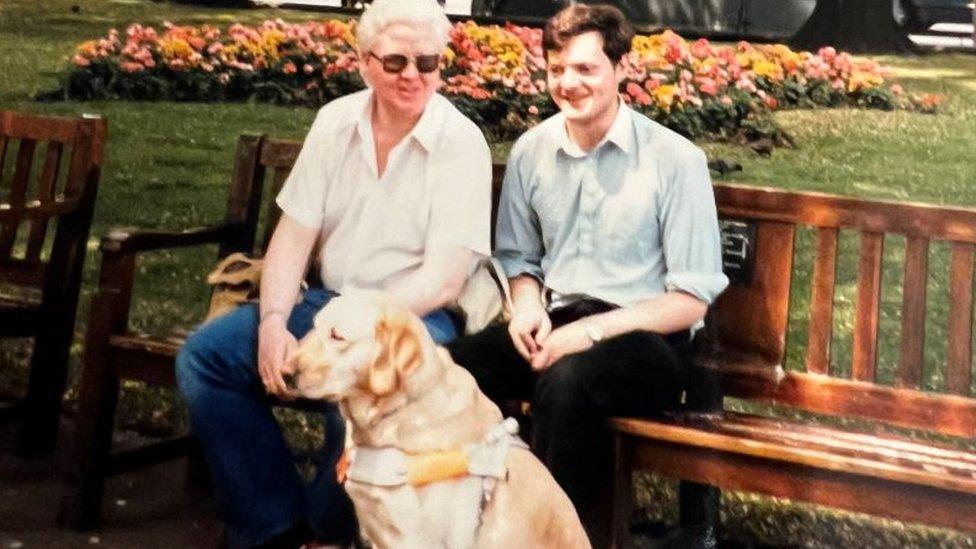
Ian still remembers getting Stella, his first guide dog, 40 years ago
It's been 40 years since I started training with my very first guide dog but the memories are still vivid.
Back then I was a slim 20-year-old student at the Royal National College for the Blind in Hereford.
I travelled up to Forfar for four weeks at the guide dog training centre, where I stayed with 11 other blind people.
We were a diverse bunch, strangers brought together by our shared journey of sight loss and desperation to maintain our independence.
I knew this training would change how I navigated the world.
No more would I have to gingerly manoeuvre my way down the streets with a white cane, desperately hoping to avoid collisions with lampposts, rubbish bins, and cars parked on pavements.
The accommodation at the centre in August 1983 was far from luxurious but clean and comfortable.
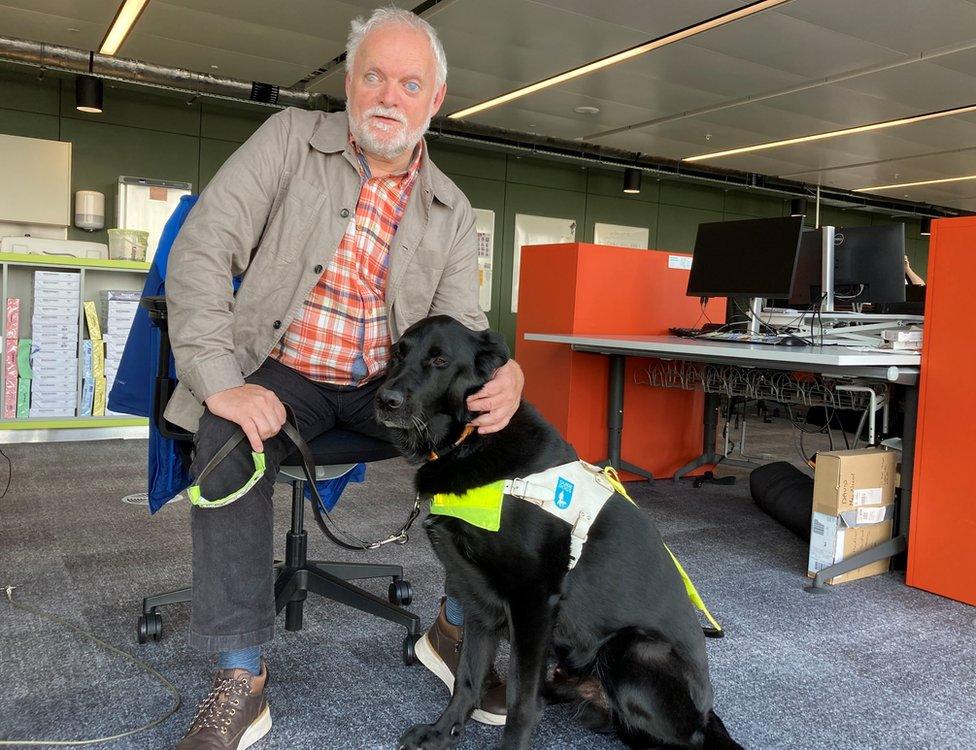
Ian, who has worked for the BBC for 23 years, with his latest guide dog Major
There was an empty dog bed and bowl waiting for my new companion but I wouldn't meet the dog for another four days.
The Guide Dog Association for the Blind was incredibly secretive back then, resembling something akin to MI5.
We weren't told anything about the dog's breed, name, or sex at the beginning, and the human trainer played the role of the dog, demonstrating the correct way to guide and give commands.
It felt a bit like "Strictly Come Dancing" without the sparkly tights and harsh judging.
The trainer would say: "Ian, put your left foot back and turn. Now, bring both feet back together and pirouette to the right. Slap your right thigh simultaneously and turn, all in one move.
"Oh, and don't forget to tell me what a good dog I am."
What a sight it must have been, the trainer and I mincing in unison around the centre's car park with me exclaiming: "Who's a good boy?"
When the time came to meet my new dog, I'd grown impatient.
The tension in the room was palpable as we were all called to gather in the large sitting room.
One by one, trainers read aloud our names and matched them with the dogs' names.
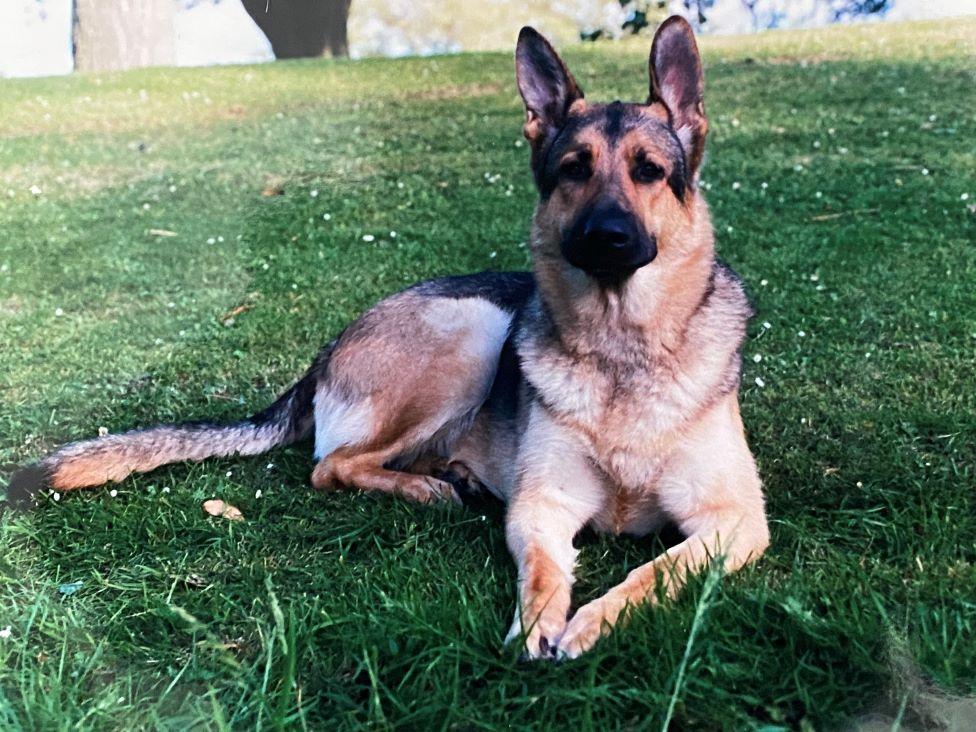
Ian's third dog, Tim, was a seven-stone German Shepherd with a personality to match
I sat there, silently praying that they wouldn't give me a dog with a stupid name.
After what felt like an eternity, I was told I'd be getting a crossbreed Labrador Retriever bitch called Ursula.
I slumped in my seat, dejected, wondering why they would give a 20-year-old lad from deepest, darkest Lanarkshire a dog with a name like that.
Before we met our dogs, we were given strict instructions about what to do and what not to do.
We were told to sit quietly in our chairs and let the dog come to us.
It was imperative that we remained calm and, under no circumstances, chase the dog frantically around the room.
There's a story about a far too excitable trainee who ignored this instruction and couldn't find their dog.
They pressed the call bell for assistance, and when the trainer returned, they found the dog sitting in the sink, hiding from its new blind owner.
A shaky start to a mutually dependent relationship.
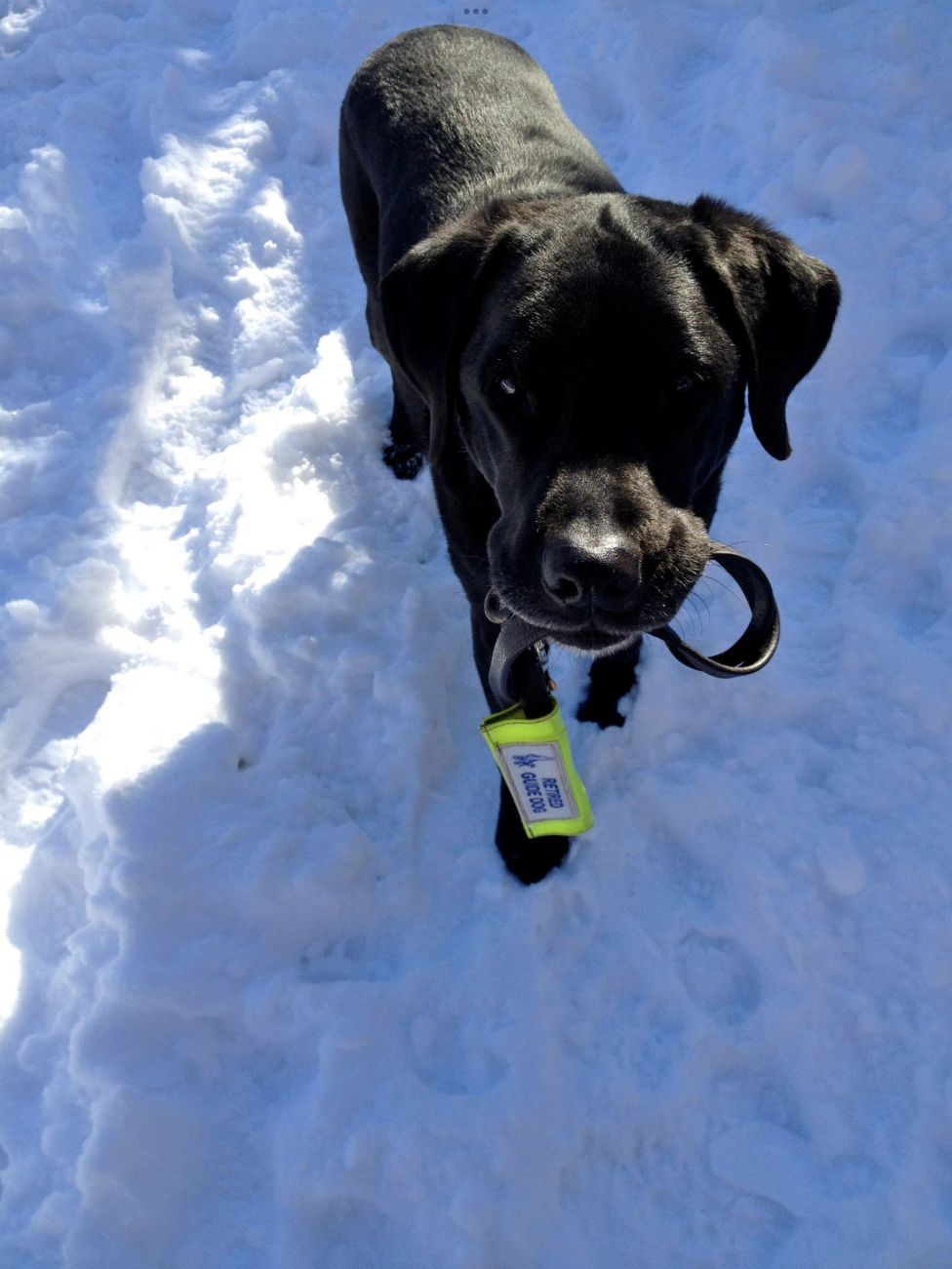
Moss, Ian's fifth guide dog, had a natural talent for stealing the limelight
Luckily for me, when Ursula was brought into my room, she bounded in and leaped straight on to my lap.
Not long afterwards, I changed her name to Stella, which I considered a much more acceptable option for a young man.
Day by day, our training expanded from basic house drills, which included walking the dog around the building on a lead, to venturing outside into the wider world and encountering various obstacles.
Initially, the trainer would always be nearby, but as the weeks passed, they would observe from a distance, scrutinising our every move.
We had cars driven at us to see how the dog and I would react, and obstacles were strategically placed in our path to test our problem-solving skills.
A lot has changed in the four decades since I was trained with my first guide dog.
Major is my seventh dog and his training required just one week in a local hotel followed by three weeks at home.
What's more, I had the chance to meet him before the training began, to see if we were a good match. Spoiler alert, we were.
Matching dogs and owners is important but the way trainers describe dogs is a bit like how estate agents talk about houses.
It took me a couple of dogs before I fully grasped this code.
When an instructor says: "This dog is a keen worker", it really means it is likely to pull you down the street at top speed.
"This dog has great initiative," translates to it will go wherever it wants, regardless of how much you protest.

Renton, Ian's sixth companion, had a unique approach to guiding
From the moody and officious to the joker and the Buddhist, every canine companion I have worked with brought a distinct character to our partnership.
For example, Stella would sulk and walk slower if we ventured somewhere she didn't fancy.
She would take revenge by skilfully avoiding puddles, delicately tiptoeing along the edges to keep her paws dry, while I found myself splashing through the deep end.
When Stella retired, I welcomed Leo, another crossbreed Labrador Retriever.
Independent by nature, Leo showed little interest in playing with other dogs and preferred the company of humans.
Although he carried out his guiding duties, he lacked enthusiasm, doing only what was necessary to keep us both alive.
My third dog, Tim, was a seven-stone German Shepherd with a personality to match.
Tim effortlessly commanded attention during train rides, his mere presence persuading passengers to vacate their seats.
He would fixate his intense gaze on people until they relented, creating a space for both of us to sit.
Weaver, my fourth dog, tended to go on strike, defiantly throwing himself to the ground and refusing to move.
Moss, my fifth guide dog, had a natural talent for stealing the limelight. He would confidently stare down TV camera lenses like a seasoned professional, becoming a familiar face on numerous television reports.
Renton, my sixth companion, also a large German Shepherd, had a unique approach to guiding. Instead of manoeuvring around people, he would gently lean on pedestrians, encouraging them to step aside and allow us to pass.
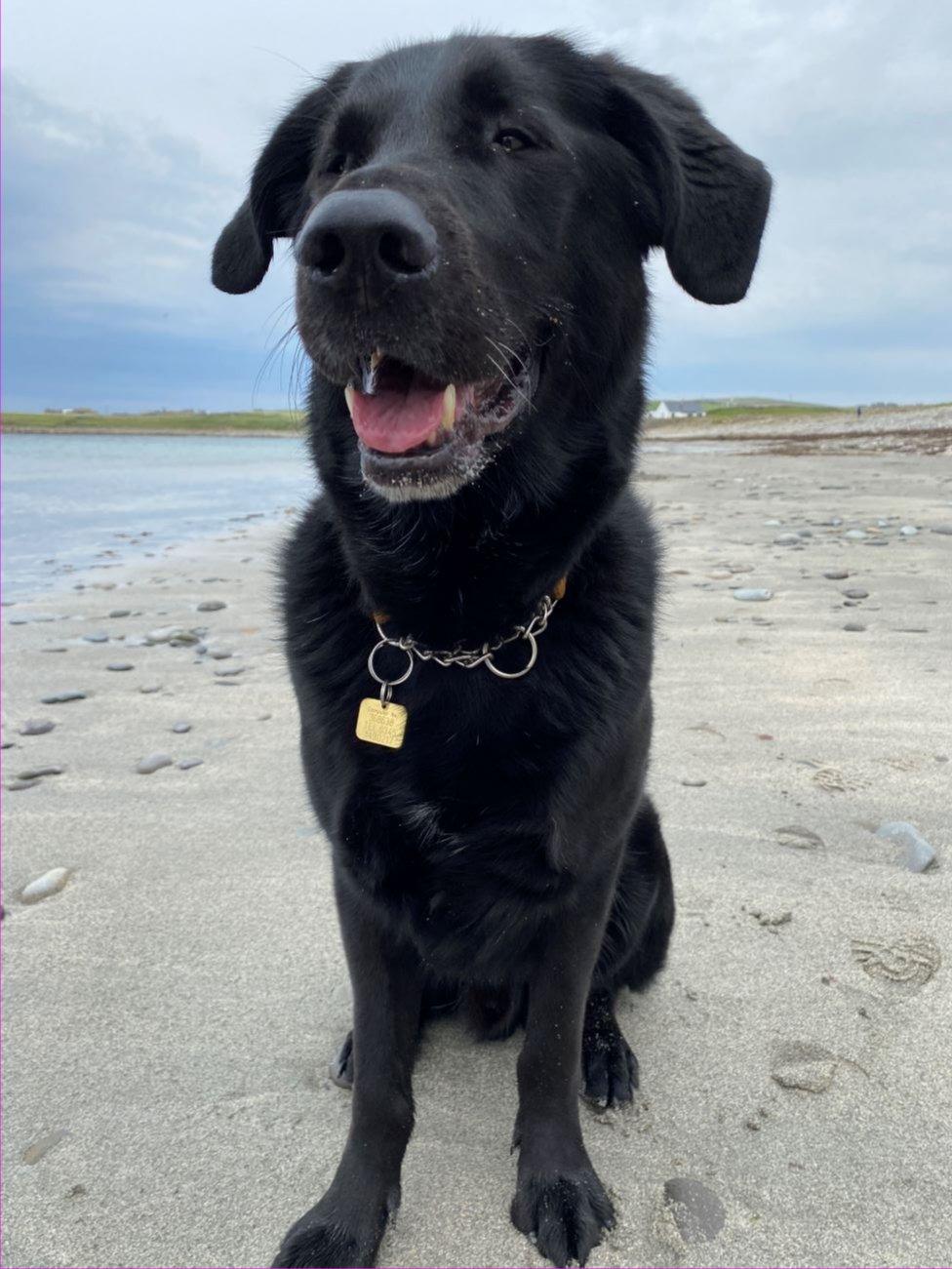
Ian's current guide dog Major takes his job very seriously
Lastly, Major, my seventh and current guide dog, takes his job very seriously.
Out of all the dogs I've had, Major demonstrates an exceptional level of understanding.
It never ceases to amaze me how much he understands.
Our interactions often feel like one-sided conversations, as I know he absorbs every word I say.
Stella lived a long and fulfilling life until she was nearly 16, and every dog I've had since has been not just a good friend but a way of breaking down barriers.
In two or three years it'll be time for Major to retire and I don't know how long it will take to get another dog.
At the moment, many people are waiting as long as two years after their previous dog retired, which is far too long to be without a reliable form of mobility.
It's difficult to pinpoint the exact reason for this, and Covid is often blamed, but many blind people believe the issues began before the pandemic.
Some attribute it to a change in training methods, which has led to a high rejection rate of dogs. A shortage of staff has also been said to be a factor.
The Guide Dogs Association says its training methods for guide dogs are in line with international standards and prioritise welfare and safety.
They say the Covid pandemic led to a pause in its breeding programme and also caused a dip in guide dog training success rates due to limited socialisation opportunities for the dogs.
They say the average wait is currently 15 months and they are taking action to address waiting times.
I hope they are because I know that guide dog training has been a lifeline for blind people for decades and will continue to be, no matter how it evolves.